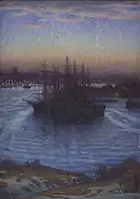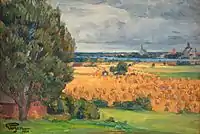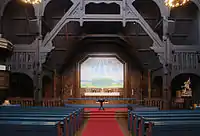Prince Eugen, Duke of Närke
Prince Eugen Napoleon Nicolaus of Sweden and Norway, Duke of Närke (1 August 1865 – 17 August 1947), was a Swedish painter, art collector and patron of artists.
| Prince Eugen | |||||
|---|---|---|---|---|---|
| Duke of Närke | |||||
 The Duke in 1910, by Anders Zorn | |||||
| Born | 1 August 1865 Drottningholm Palace, Stockholm, Sweden | ||||
| Died | 17 August 1947 (aged 82) Waldemarsudde, Stockholm, Sweden | ||||
| |||||
| House | Bernadotte | ||||
| Father | Oscar II of Sweden | ||||
| Mother | Sophia of Nassau | ||||
Background
Prince Eugen was born at Drottningholm Palace as the fourth and youngest son of Prince Oscar, Duke of Östergötland. His mother was Sophia of Nassau. The newborn prince was granted the title of Duke of Närke. Upon his father's accession to the thrones of Sweden and Norway as King Oscar II, the Duke of Närke became fourth in line to the throne. However, he was more interested in painting than in reigning.
Norway
The Duke of Närke was a great admirer of Norwegian nature and frequently visited Christiania (later known as Oslo). His letters show that he preferred its artistic milieu to the more constrained Stockholm one. His most notable Norwegian friends were the painters Erik Werenskiold and Gerhard Munthe; he remained attached to them and to Norway until his death.[1]
In 1905, the personal union between Norway and Sweden was broken by the Parliament of Norway. The writer Bjørnstjerne Bjørnson mentioned the possible candidature of Prince Eugen for the throne of Norway. Another writer, Knut Hamsun, had suggested the Prince as a suitable candidate already in 1893.[1] His father, however, refused to allow any of his sons to ascend the Norwegian throne.[2]
Prince Eugen was the only Swede represented at an exhibition in Oslo in 1904. The explanation was that he was a prince of Norway until 1905 and that his relations with the Norwegian artists caused him to be seen as Norwegian until the dissolution of the union.[1]
Art

After finishing high school, Prince Eugen studied art history at Uppsala University. Although supported by his parents, Prince Eugen did not make the decision to pursue a career in painting easily, not least because of his royal status. He was very open-minded and interested in the radical tendencies of the 1880s.[3] The Duke became one of the era's most prominent landscape painters.[4] He was first trained in painting by Hans Gude and Wilhelm von Gegerfelt.
Between 1887 and 1889,[3] he studied in Paris under Léon Bonnat, Alfred Philippe Roll, Henri Gervex and Pierre Puvis de Chavannes.[3][5] Puvis de Chavannes's classical simplicity had the greatest influence on Prince Eugen's work.[3] The Duke devoted himself entirely to landscape painting,[3] becoming one of the era's most prominent landscape painters.[4] He was mainly interested in the lake Mälaren, the countryside of Stockholm (such as Tyresö, where he spent his summers), Västergötland (most notably Örgården, another summer residence) and Skåne (especially Österlen).[3]
Prince Eugen's works
Death and legacy
Prince Eugen bought Waldemarsudde, on Djurgården in Stockholm, in 1899 and had a residence built there within a few years.[3] After his death at Drottningholm Palace on 17 August 1947, the residence became an art museum and, in accordance with his will, property of the state.[4] Eugen never married, in an era when royal princes almost always found princesses to wed. His homosexual orientation was unknown to the general public.[7]
Honours and arms
Honours
National honours[8]
- Knight and Commander of the Seraphim, 1 August 1865
- Knight of the Order of Charles XIII, 1 August 1865
- Commander Grand Cross of the Sword, 1 August 1865
- Commander Grand Cross of the Polar Star, 1 August 1865
- Commander Grand Cross of the Order of Vasa, 15 May 1897[9]
Foreign honours[8]
 Norway:
Norway:
- Knight of the Norwegian Lion, 21 January 1904[10]
- Grand Cross of St. Olav, with Collar
 Denmark: Knight of the Elephant, 31 August 1883[11]
Denmark: Knight of the Elephant, 31 August 1883[11].svg.png.webp) Austro-Hungarian Imperial and Royal Family: Grand Cross of St. Stephen, 1890[12]
Austro-Hungarian Imperial and Royal Family: Grand Cross of St. Stephen, 1890[12].svg.png.webp) Siam: Knight of the Order of the Royal House of Chakri, 13 July 1897[13]
Siam: Knight of the Order of the Royal House of Chakri, 13 July 1897[13].svg.png.webp) Spain:
Spain:
- Knight of the Golden Fleece, 15 May 1902[14]
- Grand Cross of the Order of Charles III, with Collar, 30 May 1906[15]
 United Kingdom: Honorary Grand Cross of the Royal Victorian Order, 15 June 1905[16]
United Kingdom: Honorary Grand Cross of the Royal Victorian Order, 15 June 1905[16].svg.png.webp) Belgium: Grand Cordon of the Order of Leopold
Belgium: Grand Cordon of the Order of Leopold Finland: Grand Cross of the White Rose
Finland: Grand Cross of the White Rose.svg.png.webp) France: Grand Cross of the Legion of Honour
France: Grand Cross of the Legion of Honour.svg.png.webp) Greek Royal Family: Grand Cross of the Redeemer
Greek Royal Family: Grand Cross of the Redeemer.svg.png.webp) German Imperial and Royal Family:
German Imperial and Royal Family:
- Knight of the Black Eagle
- Grand Cross of the Red Eagle
.svg.png.webp) Baden Grand Ducal Family:[17]
Baden Grand Ducal Family:[17]
- Knight of the House Order of Fidelity, 1881
- Knight of the Order of Berthold the First, 1881
.svg.png.webp) Nassau Ducal Family: Knight of the Gold Lion of Nassau
Nassau Ducal Family: Knight of the Gold Lion of Nassau.svg.png.webp) Saxe-Weimar Grand Ducal Family: Grand Cross of the White Falcon, 1882[18]
Saxe-Weimar Grand Ducal Family: Grand Cross of the White Falcon, 1882[18]
_crowned.svg.png.webp) Italian Royal Family: Knight of the Annunciation, 5 July 1913[19]
Italian Royal Family: Knight of the Annunciation, 5 July 1913[19] Latvia: Commander Grand Cross of the Three Stars
Latvia: Commander Grand Cross of the Three Stars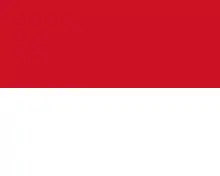 Monaco: Grand Cross of St. Charles
Monaco: Grand Cross of St. Charles Netherlands: Grand Cross of the Netherlands Lion
Netherlands: Grand Cross of the Netherlands Lion.svg.png.webp) Portuguese Royal Family: Grand Cross of the Tower and Sword
Portuguese Royal Family: Grand Cross of the Tower and Sword Romanian Royal Family: Grand Cross of the Star of Romania
Romanian Royal Family: Grand Cross of the Star of Romania Russian Imperial Family:
Russian Imperial Family:
.svg.png.webp) Turkish Imperial Family: Order of Osmanieh, 1st Class
Turkish Imperial Family: Order of Osmanieh, 1st Class
Arms
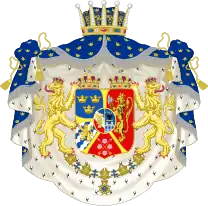 Arms as Prince of Sweden and Norway, Duke of Närke 1865 to 1905 |
.svg.png.webp) Arms as Prince of Sweden and Duke of Närke 1905 to 1947 |
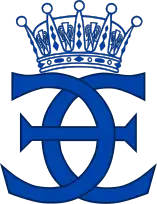 Royal Monogram of Prince Eugen of Sweden |
References
- Barton, Hildor Arnold (2003). Sweden and Visions of Norway: Politics and Culture, 1814-1905. Southern Illinois University Press. ISBN 0809324415.
- Haakon VII Biography of King Haakon VII in connection with NRK's series "Store norske" (Great Norwegians) (in Norwegian)
- "Prince Eugen". Retrieved 3 February 2013.
- "Prins Eugens Waldemarsudde". Prins Eugens Waldemarsudde. Archived from the original on 19 August 2010. Retrieved 3 February 2013.
- "Eugen Napoleon Nicolaus". Store norske leksikon. Retrieved 3 February 2013.
- "Waldemarsuddekrukan pothistory". www.museibutiken.se. Archived from the original on 2013-04-18.
- Lindqvist, Herman (2013-08-03). "Stort hysch om kungars sexualitet". Aftonbladet (in Swedish). Retrieved 15 May 2017.
- Sveriges statskalender (in Swedish), 2, 1947, p. 6, retrieved 2018-01-06 – via runeberg.org
- Sveriges statskalender (in Swedish), 1925, p. 935, retrieved 2018-01-06 – via runeberg.org
- kongehuset.no - The Order of the Norwegian Lion
- Bille-Hansen, A. C.; Holck, Harald, eds. (1944) [1st pub.:1801]. Statshaandbog for Kongeriget Danmark for Aaret 1944 [State Manual of the Kingdom of Denmark for the Year 1944] (PDF). Kongelig Dansk Hof- og Statskalender (in Danish). Copenhagen: J.H. Schultz A.-S. Universitetsbogtrykkeri. p. 16. Retrieved 4 May 2020 – via da:DIS Danmark.
- "A Szent István Rend tagjai" Archived 22 December 2010 at the Wayback Machine
- Royal Thai Government Gazette (9 March 1898). "พระราชทานเครื่องราชอิสริยาภรณ์ ทีประเทศยุโรป" (PDF) (in Thai). Retrieved 2019-05-08. Cite journal requires
|journal=(help) - "Caballeros de la insigne orden del toisón de oro", Guía Oficial de España (in Spanish), 1915, p. 194, retrieved 5 May 2020
- "Real y distinguida orden de Carlos III". Guía Oficial de España (in Spanish). 1915. p. 198. Retrieved 5 May 2020.
- The London Gazette, issue 27807, p. 4251
- Hof- und Staats-Handbuch des Großherzogtum Baden (1896), "Großherzogliche Orden" pp. 62, 76
- Staatshandbuch für das Großherzogtum Sachsen / Sachsen-Weimar-Eisenach (1900), "Großherzogliche Hausorden" p. 16
- Italy. Ministero dell'interno (1920). Calendario generale del regno d'Italia. p. 58.
